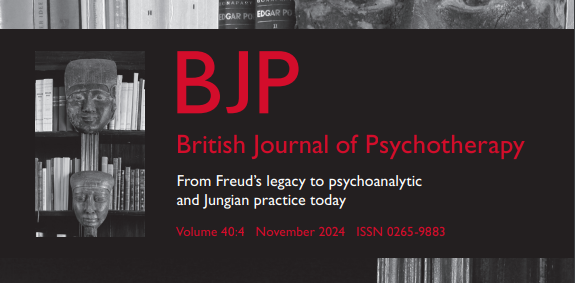The November 2024 issue of the British Journal of Psychotherapy (Vol. 40, Issue 4) offers an in-depth exploration of key topics in psychotherapy through a wide array of articles and reviews.
Editorial: Gary Winship opens with reflections on psychotherapy’s evolving landscape.
“Inkblots, Psychotherapy and the Tavistock Clinic” (open access) by Janet Sayers examines the Tavistock Clinic’s historical role in the development of psychotherapeutic practices, notably Rorschach tests. It traces the institutional and cultural significance of the clinic and its contributions to therapeutic methods, shedding light on the clinic’s engagement with symbolic imagery like inkblots in psychoanalytic therapy.
Session Frequency or Working Model? Laurence Spurling, Jan McGregor Hepburn, and Ronald Doctor investigate the clinical differences between intensive and non-intensive psychotherapy. This comparative analysis draws on case studies to reveal how variations in session frequency impact the therapeutic process. They argue that session intensity can significantly influence both the therapist’s and client’s emotional responses, posing different opportunities and challenges in therapeutic work.
“Mourning the Loss of the Ideal Self” (open access) by Marcus Evans delves into short-term psychotherapy with a transgender patient post-transition. This paper reflects on the complex psychological landscape during this period, including grief for the loss of an ‘ideal self’ that existed pre-transition. It offers a nuanced view of post-transition therapy, where the patient navigates identity reconstruction and the mourning of past selves.
“Analytic/Jungian Psychotherapy and Same-Sex/Queer Desire” by Wayne Full highlights queer desire in the context of Jungian analysis. This paper suggests that the traditional frameworks of psychoanalysis need to evolve to better accommodate the lived experiences and psychodynamics of LGBTQ+ individuals, especially in training and theory formulation.
“Psychodynamic Psychotherapy for Time Distortion in ADHD“ by Matthew Rinaldi focuses on how ADHD patients experience distorted time perceptions and offers insights into how psychodynamic psychotherapy can address these challenges. Rinaldi emphasizes the need to understand the underlying psychodynamic mechanisms contributing to time management difficulties.
A Qualitative Study on Psychotherapy Competencies and COVID-19’s Impact by Alan Baban et al. explores how psychiatric trainees acquire psychotherapy skills and how COVID-19 altered the learning landscape. The study sheds light on the adaptability of training programs and the creative solutions employed during the pandemic.
Scarlett de Courcier’s “The Visible and the Invisible” (open access) offers a psychoanalytic perspective on the themes of secrecy and exposure in therapy. De Courcier explores the impact of the ‘gaze of the Other’ in therapeutic contexts, particularly how unconscious desires manifest in the therapeutic space.
To Eat, or Not to Eat? by Rhett-Lawson Mohajer and colleagues is a psychoanalytic exploration of parental attitudes towards food, unpacking how these attitudes reflect deeper psychological conflicts and familial dynamics. It looks at the “food-parent” phenomenon and its broader implications for psychotherapy.
Prize Paper: “Creativity and Deadness“ by Elżbieta Sala-Hołubowicz argues for a more fluid understanding of the true/false self dichotomy, suggesting that psychoanalytic theory often limits patients’ ability to express creativity and aliveness. This paper challenges conventional approaches and proposes a more nuanced view of psychic life.
The issue also includes several book reviews, such as Yola Gómez’s review of Psychoanalysis Under Occupation, which discusses practicing psychotherapy in politically and socially occupied territories, and Rose Baring’s critique of Credo: R. D. Laing and Radical Psychotherapy, highlighting Laing’s influence on modern psychotherapy.
To read the full issue, click here.

